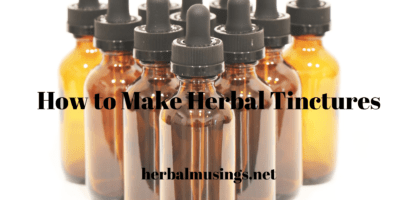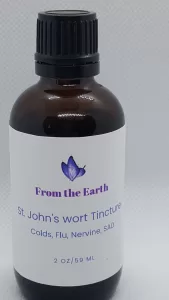An herbal tincture is a long lasting and effective form of receiving an herbs gift. Tinctures are herbal preparations that use something beyond water as a solvent. Using a solvent like alcohol, vinegar, or glycerin, you can extract a greater spectrum of the whole plant and preserve the medicine
much longer. Alcohol is an excellent solvent that extracts a wide range of plant properties and allows for easy absorption of healing compounds into the bloodstream.
I can not stress enough how important it is to research any plants you want to use for medicine. Read about the plant, learn where it grows, what it looks like and what are the medicinal properties.
What Is A Tincture?
Tinctures are concentrated herbal extracts. All tinctures are extracts, but not all extracts are tinctures!
Alcohol must be the solvent used to extract the herbal properties. If you are using vinegar, glycerine, only water (water used to dilute alcohol is fine), or any solvent other than alcohol, your preparation is an extract, but it is not a tincture. Any spirit may be used, but many herbalists prefer something neutral like vodka so the taste of the herb comes through.
They can be made with fresh or dried flowers, leaves, roots, barks, or berries.
You can take tinctures straight, squirting a dropper full under your tongue or you can dilute it in a glass of water.
How To Make Tinctures
Supplies
- Clean glass jar
- Scissors
- Tape
- Pen
- 100% vodka
Directions
- On a nice sunny dry day go out to a vacant lot or field to collect the plants.
- Cut just the top third of the plants using the leaves, stems and flowers.
- Put these loosely in your empty, clean jar. Using your scissors snip the plants in the jar so they are small pieces.
- Fill your jar almost to the top, next fill the jar with 100% vodka using a stick to tamp around the jar to release any air bubbles.
- Make sure all the herbs are covered with vodka. Cap and label your jar with the name of the plant, the date you made it and the date it will be ready to use.
- Shake the jar once a day for 2 weeks and store in a cool, dark, dry place.
Straining the herbs
- In 4-6 weeks your tincture is ready to use.
- Now you need to strain the plant material. Take some cheesecloth and drape it over a measuring cup and secure it with a rubber band.
- Pour the plant material and liquid in the cheesecloth, gather the edges of the cheesecloth up and squeeze all the liquid out.
- Discard the plant material in the compost.
- Your tincture can be stored in amber glass bottles.
Tinctures are fast acting and are easily absorbed into your system. A few drops of tincture in a glass of water is all you need.
Kept in a cool, dry, dark place your tincture will last indefinitely.
Try Before You DIY
Elderberry tincture is known for its efficiency in treating cold and flu symptoms due to its strong pain relieving properties. Long used throughout Europe and the Americas, elderberry has a long and respected history as an herbal remedy.
Elderberries are high in vitamin C and contain a moderate amount of vitamin A, vitamin B6, and iron. Elderberries ease inflammation, anti rheumatic, antioxidant and diuretic.
St. John’s Wort is a restorative tonic to the entire nervous system, calming and soothing frayed nerves or when you feel anxious, nervous or irritable. St. John’s Wort regulates hormonal activity too, since its active ingredients have strong effects on hormone regulation. The herb can lessen hypothyroidism symptoms and aids the thyroid gland in producing adequate amounts of hormones.
I have several tinctures for sale in my online shop.



Comments are closed.